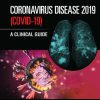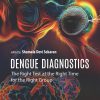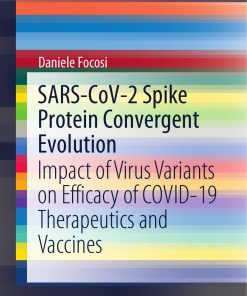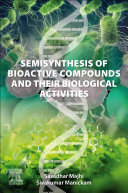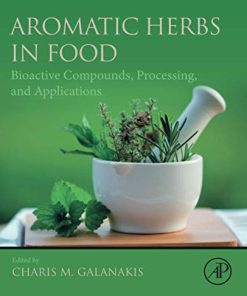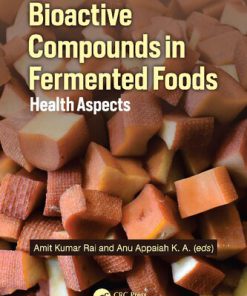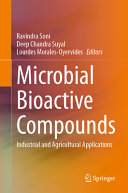Bioactive Compounds Against SARS CoV2 1st Edition by Jen Tsung Chen ISBN 9781000909098 1000909093
$50.00 Original price was: $50.00.$25.00Current price is: $25.00.
Bioactive Compounds Against SARS CoV2 1st Edition by Jen Tsung Chen – Ebook PDF Instant Download/Delivery: 9781000909098 ,1000909093
Full download Bioactive Compounds Against SARS CoV2 1st Edition after payment
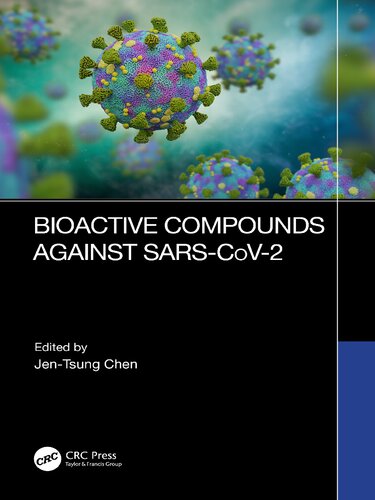
Product details:
ISBN 10: 1000909093
ISBN 13: 9781000909098
Author: Jen Tsung Chen
Bioactive Compounds Against SARS CoV2 1st Edition Table of contents:
Chapter 1 Omics-Guided Intervention Strategies in Combatting SARS-CoV-2: Recent Advancements and Challenges
1.1 Introduction
1.2 Origin of SARS-CoV-2
1.3 Pathophysiology of COVID-19
1.4 Omics-Guided Therapeutic Strategies
1.5 Conclusions and Future Directives
Acknowledgments
References
Chapter 2 The Application of Computer-Aided Drug Design Methods for Developing Natural Compound-Based Therapeutics Against SARS-CoV-2
2.1 Introduction
2.2 What Is a Computer-Aided Drug Design Approach (CADD)? Types? Related Software?
2.3 How Has CADD Elevated the Entire Drug Development Pipeline?
2.4 Natural Compound Libraries Used for CADD Against SARS-CoV-2
2.5 Remarkable Successes of CADD in Designing Natural Compound-Based Therapeutics for COVID-19 Treatment
2.6 The Challenges and Scope Associated with CADD
2.7 Conclusions
Acknowledgments
References
Chapter 3 Therapeutic Targets of Host Factors for Potential COVID-19 Treatments
3.1 Introduction
3.2 General Replication Cycle of SARS-CoV-2
3.3 High-Content Screening of Host Factors
References
Chapter 4 Phytocompounds: A Paradigm Shift as Therapeutics for COVID-19
4.1 Introduction
4.2 Alkaloids
4.3 Phenolics
4.4 Terpenes
4.5 Organosulfur Compounds
4.6 Conclusions
Acknowledgments
References
Chapter 5 Flavonoids as Potential Therapeutic Agents Against the SARS-CoV-2 Infection: An Overview
5.1 Introduction
5.2 Flavonoids and Their Classification
5.3 SARS-CoV-2, Related Pathologies and Lead Drug Targets
5.4 Flavonoids as Therapeutics Against SARS-CoV-2
5.5 Conclusions
References
Chapter 6 Antiviral Activities of Flavonoids Against COVID-19 and Other Virus-Causing Ailments
6.1 Introduction
6.2 Types of Flavonoids
6.3 Respiratory Virus
6.4 Effects on Different Organs
6.5 Effects of Flavonoids
6.6 Conclusions
References
Chapter 7 Potential Therapeutic Effects of Flavonoids Against the COVID-19 Infection: The Mode of Action
7.1 Introduction
7.2 Biological and Structural Organization of SARS-CoV-2
7.3 Druggability of SARS-CoV-2 and Treatment Opportunities
7.4 Discussion on the Potential Antiviral Properties of Flavonoids
7.5 Prospects of Using Flavonoids as Potential Anti-SARS-CoV Virus Agents
7.6 Conclusions
References
Chapter 8 Terpenes and Terpenoids: Potent Antiviral Agents Against SARS-CoV-2
8.1 Background
8.2 Initial Backdrop of the Disease
8.3 Initial Therapeutic Options in Coronavirus Treatment
8.4 Possible Disadvantages of Synthetic Medicines and Vaccines
8.5 Natural Products as a Therapeutic Option Against SARS-CoV-2
8.6 Terpene-A Natural Product
8.7 The Action of Terpenes Against SARS-CoV-2 (Selected Studies/Examples)
8.8 Terpenes from Marine Organisms: Potential Anti-SARS-CoV-2 Agents
8.9 Present Status of Use of Terpenes in Pharmaceutical Industries to Counter SARS-CoV-2 and Allied Viruses
8.10 Mechanism of Action of Terpenes and In Silico Approaches Against SARS-CoV-2
8.11 Prospects and Conclusive Remarks
References
Chapter 9 Phytonutrients and Secondary Metabolites to Cease SARS-CoV-2 Loop
9.1 Introduction
9.2 Phytochemicals
9.3 Phytonutrients and Secondary Metabolites
9.4 Sources and Functions of Phytonutrients and Secondary Metabolites with Antiviral Activity
9.5 Antiviral Activity of Phytonutrients and Secondary Metabolites Against SARS-CoV-2
9.6 Conclusions
References
Chapter 10 Treatment Strategies Against COVID-19 Using Bioactive Compounds and Plant Secondary Metabolites
10.1 Introduction
10.2 Genomic Organization of SARS-CoV-2
10.3 Life Cycle of SARS-CoV-2
10.4 Pathogenesis of SARS-CoV-2
10.5 Treatment Strategies of SARS-CoV-2
10.6 Ethnobotanically Important Plants Presenting Potent Antiviral Activity
10.7 Natural Composites Accustomed to Controlling SARS-CoV-2
10.8 Biotechnological Approaches to Enhance the Production of Secondary Metabolites
10.9 Conclusions and Future Recommendations
Compliance with Ethical Standards
References
Chapter 11 The Potential Contribution of Vitamin K as a Nutraceutical to Scale Down the Mortality Rate of COVID-19
11.1 Introduction
Vitamin K
11.3 The Deficiency of Vitamin K And COVID-19
11.4 Plausible Mechanisms for Vitamin K Against SARS-CoV-2
11.5 Vitamin K Antagonist
11.6 Biomarkers to Detect Vitamin K Deficiency
11.7 Vitamin K is a Potent Nutraceutical
11.8 Possible Potentials of Vitamin K as an Anti-COVID-19 Agent
11.9 Conclusions
References
Chapter 12 Gastrointestinal Symptoms in COVID-19 Patients: Prevention and Treatment
12.1 Introduction
12.2 Gastrointestinal Symptom Manifestations
12.3 Gastrointestinal Symptoms Management
12.4 Medicinal Plants are Commonly Used in Morocco to Treat Gastrointestinal Disorders
12.5 Major Issues Remain Largely Unexplored
12.6 Recommendations to Manage the Manifestation of Gastrointestinal Symptoms Induced by COVID-19
References
Chapter 13 Mechanisms and Management Options of Liver Injury in COVID-19: A Review
13.1 Introduction
13.2 Action Mechanisms
13.3 Management and Prevention
13.4 Conclusions
References
Chapter 14 Marine Species-Derived Bioactives Against Coronavirus Disease
14.1 Introduction
14.2 The Entry of SARS-CoV-2
14.3 Druggable Targets
14.4 Marine Bioactive Compounds
14.5 Conclusions
14.6 Limitations
References
Chapter 15 Potential Bioactive Compounds of Indian Flora Against SARS-CoV-2
15.1 Introduction
15.2 Phenolic Compounds
15.3 Terpenoids
15.4 Alkaloids
15.5 Conclusions
References
Chapter 16 Natural Product-Derived Active Compounds for the Management of COVID-19: A Summary from Indochina
16.1 Introduction
16.2 Natural Sources and Natural Products for COVID-19 Management
16.3 Current Research and Perspectives in Southeast Asia
16.4 Conclusions
References
Chapter 17 Novel Therapeutic Strategy Based on Nanomedicine Targeting Thrombosis for SARS-CoV-2
17.1 Introduction
17.2 Thrombus Formation in COVID-19 Patients
17.3 Antithrombotic Necessity and Strategy for COVID-19 Patients
17.4 Nanomedicine as a Novel Therapeutic Strategy for COVID-19
17.5 Vaccine-Induced Immune Thrombotic of COVID-19
17.6 Conclusions and Future Perspectives
Acknowledgments
References
Chapter 18 Nanomaterials in Combating Human Coronavirus Infections
18.1 Introduction
18.2 Coronavirus
18.3 Challenges Faced with Antiviral Therapy
18.4 Nanotechnology
18.5 Nanoparticles in the Viral Arena
18.6 Conventional Nanoparticles Strategically Adopted for Treating SARS-CoV-2
18.7 Other Possible Bio-Inspired Nanoparticles Strategically Adopted for the Treatment of SARS-CoV-2
18.8 Point-of-Care Devices
18.9 Affordability of Nanoparticle-Based Medicines
18.10 Conclusions
References
Chapter 19 Structural Insights into Drug Targets from MERS, SARS-CoV, and SARS-CoV-2 and Scope for Phytochemicals as Broad-Spectrum Antivirals and Immunomodulators
19.1 Introduction
19.2 Article Search and Methodology
19.3 Key Viral Proteins of Hcovs and Their Role in the Life Cycle of the Virus
19.4 Conservations of Key Viral Proteins among HCoVS
19.5 Conclusions
References
Chapter 20 Precision Phytochemicals for COVID-19-Induced Olfactory Dysfunction
20.1 Introduction
20.2 Symptoms of COVID-19
20.3 Chemosensory Dysfunction Caused by COVID-19
20.4 Phytochemicals with Anti-Inflammatory Effects
20.5 Phytochemicals with Binding Affinity with SARS-CoV-2
20.6 Signaling Pathways
20.7 Future Directions for Clinical Treatment Options with Precision Phytochemicals
References
Index
People also search for Bioactive Compounds Against SARS CoV2 1st Edition:
bioactive compounds against covid-19
a sars-cov-2 protein interaction map reveals targets for drug repurposing
bioactive compounds review
what is a bioactive compound
bioactive b-complex
Tags:
Jen Tsung Chen,Bioactive Compounds,SARS CoV2
You may also like…
Uncategorized
Relationships & Lifestyle - Diet & Nutrition
Medicine
Computational Modelling and Imaging for SARS-CoV-2 and COVID-19 1st Edition S. Prabha (Editor)
Biology and other natural sciences - Microbiology
Medicine - Others
Medicine - Molecular Medicine

